Fish spearing is an ancient fishing method, most probably dating back many thousands of years.
In New South Wales, long before white settlement, our original inhabitants were highly skilled at fish spearing as a means of providing food.
Fish spearing was usually carried out at night while wading in shallow water carrying a torch made from sticks to attract the fish.
A typical spear was constructed of wood, one end being sharpened to a point and hardened and polished. These spears were typically 1.5 to 2 metres in length. Multi – pronged spears were also used. Made entirely of hardwood they were 3.5 to 4 metres in length.
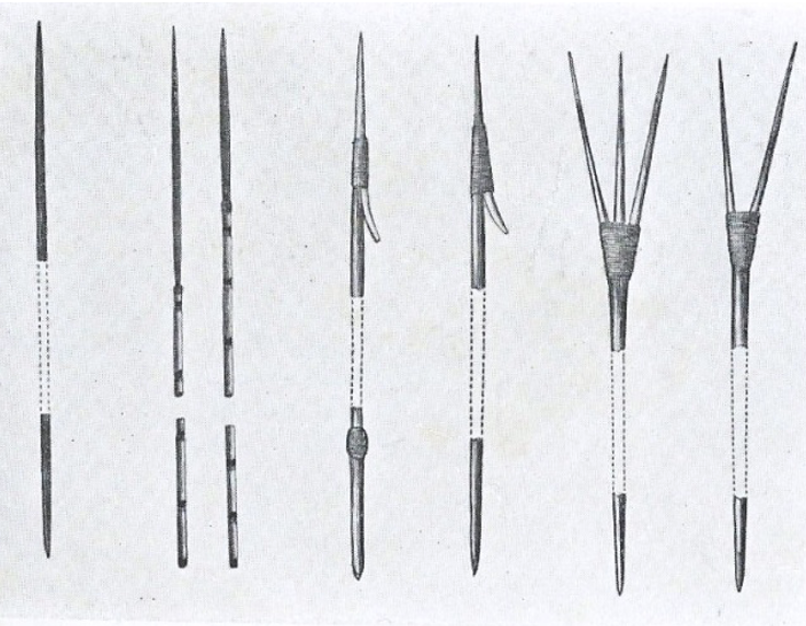
Aboriginal fishing spears
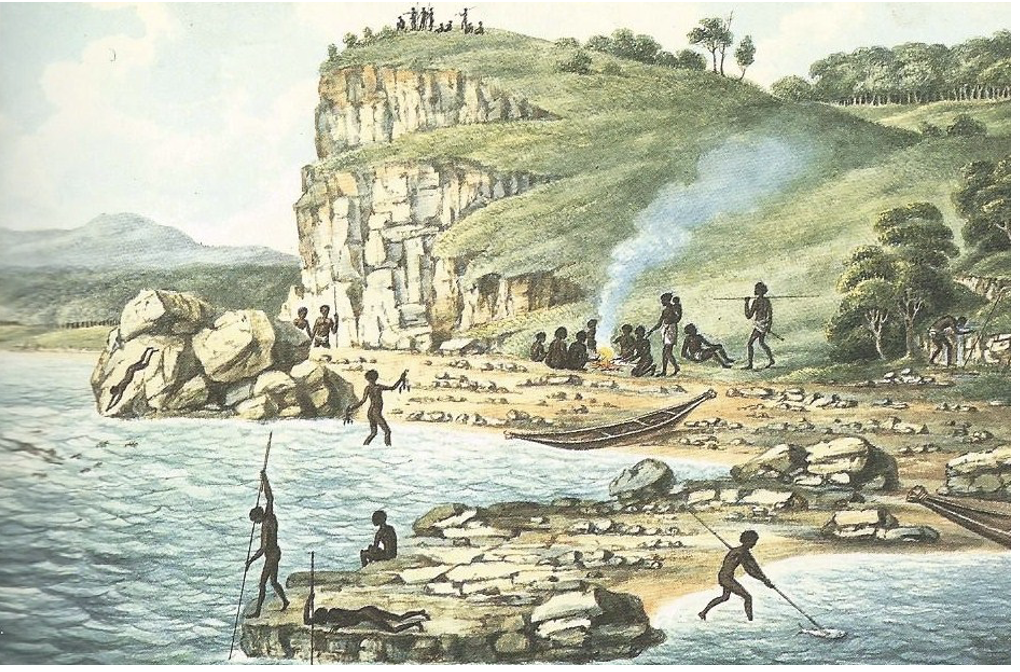
An 1830 Watercolour by Joseph Lycett showing Aboriginals spearing fish
Over 100 years ago in 1917 spearfishing as we know it today, had its beginnings when ALICK WICKHAM was credited with being the first exponent of this fishing method, after he began spearfishing around the shores of Sydney Harbour.
Alick Wickham was the son of Frank Wickham, an English sea trader who in 1875 had settled in the Solomon Islands after being shipwrecked. Frank settled on the Island of Hopeka, managing a Copra plantation. Alick’s mother was a Melanesian from the nearby settlement of Munda on the shores of Roviana lagoon.Pacific Islanders had developed their breathhold diving skills over many centuries and certainly were spearing fish underwater long before Europeans. It is fitting therefore that our first record of spearfishing in Sydney Harbour was from a young man who was born in the Solomon’s. Alick gained fame as the person who introduced the swimming stroke which became known as the Australian Crawl and in 1918 attained international fame with a 62.7 metre world record high dive from a cliff-top tower in to the Yarra River, 6 metres higher than the roadway of the Sydney Harbour Bridge.Alick remained in Sydney until 1926 when he returned to Roviana Lagoon following the death of his father.
In 1920 when Bill Heffernan was 12 years of age and living at Tamworth he began to look under the water in the Peel River. After making a spear by inserting a sharpened piece of fencing wire into a wooden stick he was successful in spearing his first fish, a catfish.
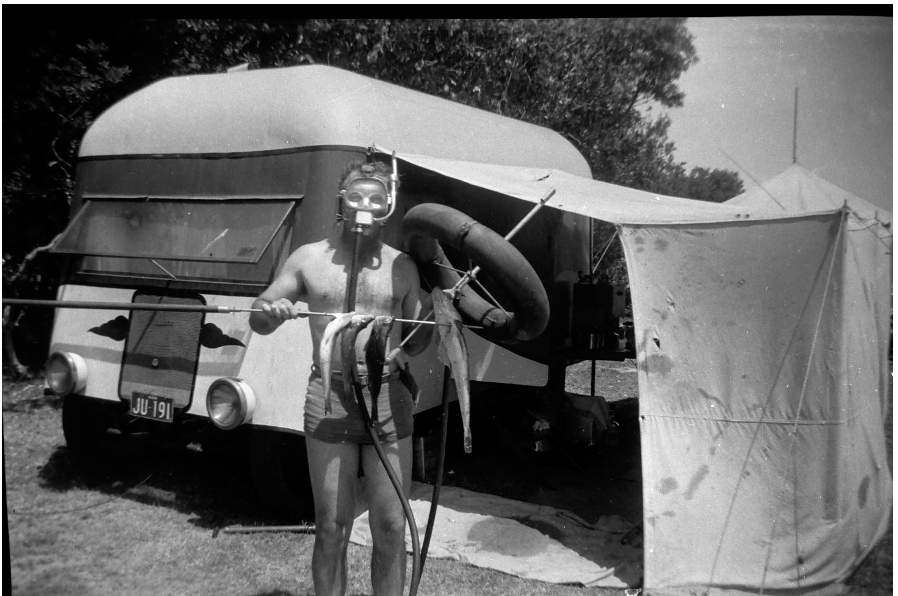
Bill Heffernan with a catch using his handspear – 1930’s
In 1946 Bill moved to The Entrance on the central coast and pioneered spearfishing in this area. He soon discovered his handspear was inadequate and designed and made his first speargun. Improvements in design followed and by 1949 was manufacturing and selling a wooden speargun known as the “Heffernan” and a silver anodised duralium speargun marketed as the “Tarpon”.
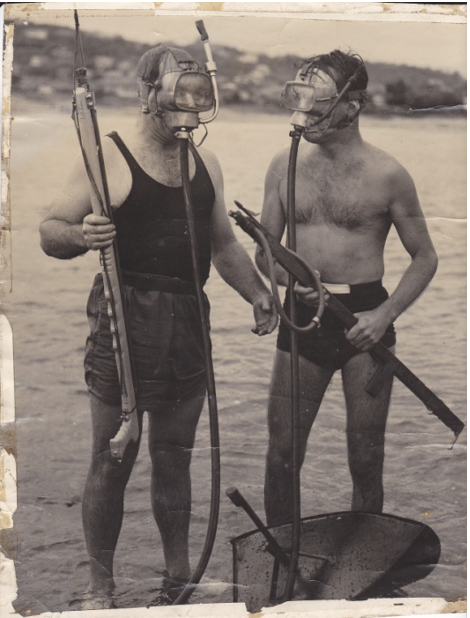
BILL HEFFERNAN (Left) and LES GLEESON at THE ENTRANCE IN 1947
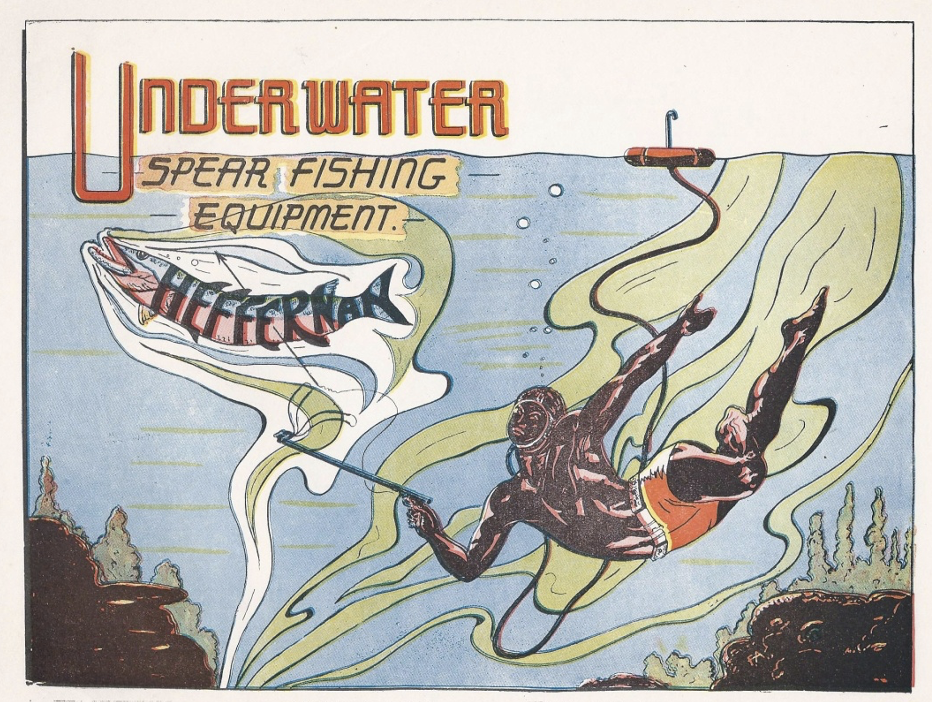
During 1926 16 year old Denny (David Denzel) Wells began diving around the rocky shores of Sydney Harbour wearing a pair of goggles. These were soon discarded and goggles with a single faceplate made. Upon finding that he suffered from eye squeeze a facemask was designed which incorporated a space for the nose.
Denny was very inventive, designing and making all of his spearfishing equipment. Denny was responsible for the design of the speargun trigger mechanism that is still in use in the “Undersee” range of spearguns today. It has been widely copied throughout the world.By the time of the great depression during the 1930’s Denny had married and his wife May took up spearfishing which provided a valuable supplemental food source during this difficult time. May has the honour of being the first female spearfisher in this country.
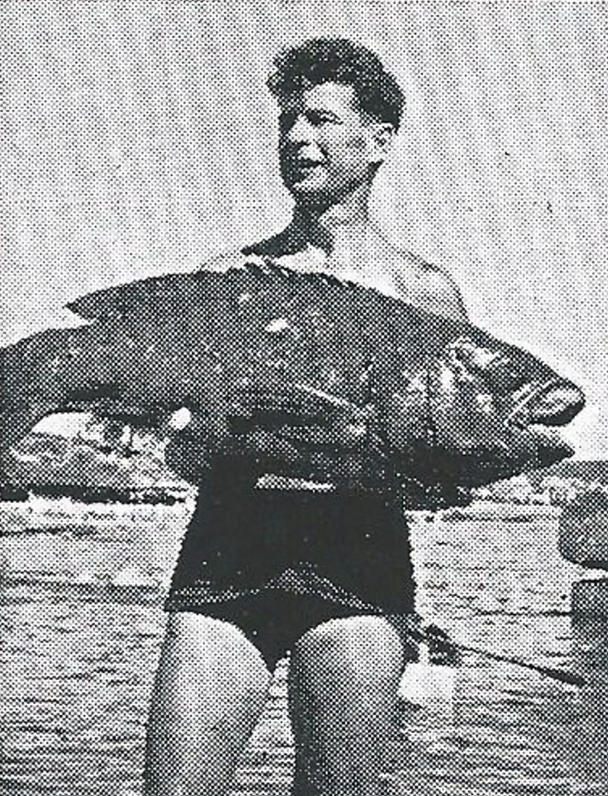
Australia's most skilful spear fisherman, Denny Wells, with a 301b. blue groper.
Fish of this size require experience and skill to land.
Dick Charles had become interested in spearfishing in about 1937. Using an old mirror with the silver scraped off and fitted into an old tyre tube he made his first mask and ‘opened up an entirely new world’. For a spear he bought some shark hooks, straightened them out and fixed them to an eight feet piece of wood. Dick was a convincing salesman who would try his hand at anything and had established a motor trading business in Hurstville in 1924 and also built and sold caravans.
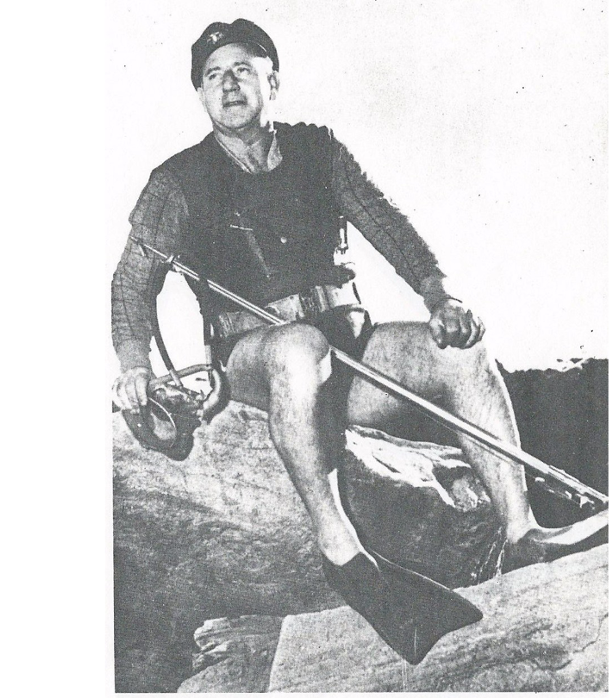
Dick Charles president U.S.F.A.-Underwater Spear Fishermen's Association
By 1940 other spearfishers had arrived on the scene. Frank Cunliffe became interested in diving after seeing a youth wearing diving goggles. He experimented with them and finally made a single lens mask which covered the eyes and nose and gave something like normal vision underwater. He began spearfishing in 1940, spearing his first fish at Lake Conjola on the 17th March 1940. From Frank’s notes “My first catch by new method of fishing. I have a 4ft. By ¼ inch steel spear which is fired by means of a catapult arrangement. The spear can be fired about 20 feet through the water but to use it I dive down and sneak up to within 3 feet of a fish before firing. I have a greenhide belt containing 9 lbs. of lead to facilitate the ‘sneaking’ upon the fish. I can get quite close by avoiding sudden movements”. Frank tried many different speargun designs before settling on a successful design. He applied for a patent for this and a diving mask during 1941 with the patents being granted in 1942. He began making sets of spearfishing equipment consisting of mask, weight belt and speargun which he sold for six pounds and ten shillings under the name of the “Ming” speargun outfit.
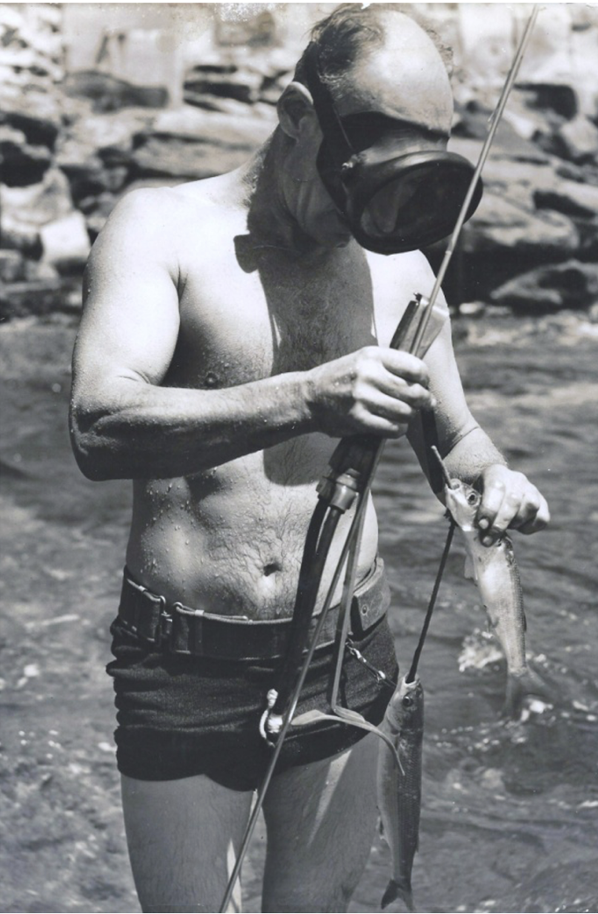
FRANK CUNLIFFE WITH HIS “MING” SPEARFISHING OUTFIT
In these early days, before the advent of flippers and snorkels, individual spearfishers were unknown to each other, developing and making their own equipment, gaining ideas from the limited publications dealing with the sport.
Having been inspired by an article in 1939 that appeared in Popular Science magazine, “Human Submarine Shoots Fish with Arrows”, the brothers George and Trevor Davies began diving around the shores of Lake Macquarie with a homemade mask and wearing sandshoes to protect their feet.
The first speargun they made was constructed of cast aluminium with a handle moulded in the middle. The spear passed through a hole drilled along the entire length of the casting. A continuous rubber band attached to the front of the gun had a brass sling at the other end with a collar arrangement to take the spear. This design did not work for them and blaming the rubber band propulsion for this they redesigned the gun, attaching a rather lengthy spring at the rear as a means of propulsion for the spear. This development proved more accurate, but the gun was still sadly lacking in power. The spring was then discarded in favour of a built in piston, cylinder and hand pump at the rear of the gun. The spear forced back the trigger mechanism until the spear was engaged and the hand pump then used to boost the cylinder pressure.

GEORGE AND TREVOR DAVIES FIRST COMPRESSED AIR SPEARGUN
Over the next few years the design was further refined resulting in the “Aquamatic” speargun which they described as the world’s first self-contained speargun. About 50 to 60 of these were made and sold, mainly in the Newcastle area, though one was exported to the USA, for which they never received payment.

GEORGE DAVIES WITH EXPERIMENTAL AQUAMATIC IN 1949

During the Second World War many servicemen had experienced duty in the Pacific Islands and had seen and been taught spearfishing by the Islanders. One such person was Don Linklater. Don had seen action on many fronts before being promoted to Lieutenant and given command of a company from the Torres Straight Light Infantry Battalion. It was in Torres Straight he was taught to dive by the Islanders and discovered an intense passion for the underwater world which was to become so much a part of his life.
In 1947 Don commenced manufacturing skindiving equipment from his Bondi home with his first product advertised as the Undersee Swimmers Mask, leading to a complaint of patent infringement by Frank Cunliffe. In December of 1949 his first speargun, the Loxin was introduced at a price of Six Pounds Ten Shillings. This speargun was so named due to its unique trigger mechanism which enabled the spear to be ‘locked’ in place.
1951 Saw the introduction of the Sabre and Super Sabre (with twin rubbers) spearguns and the first use of Denny Wells trigger mechanism. 1951 also saw the introduction of the compact Undersee Hornet Speargun which used a friction trigger.
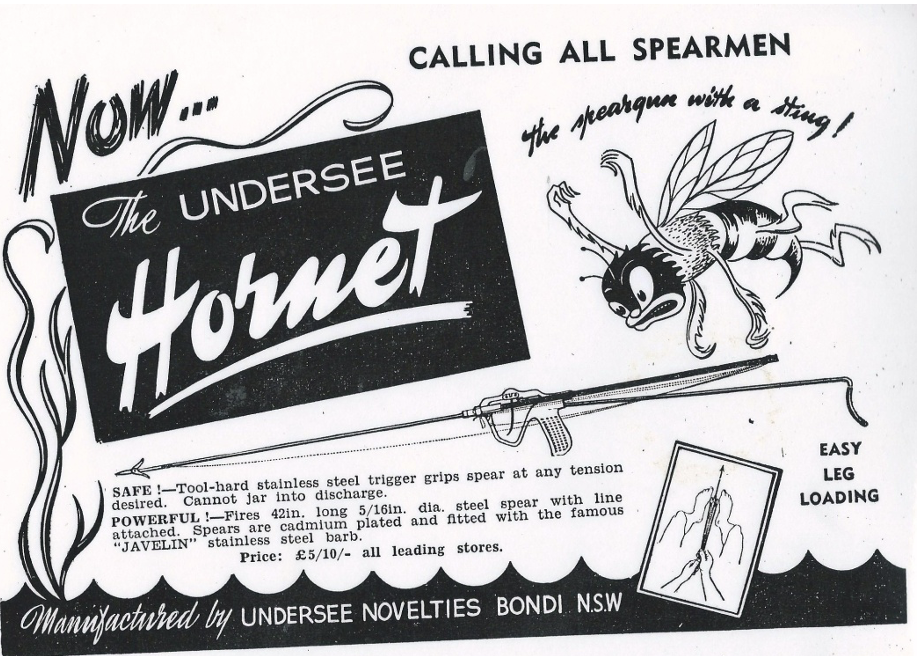
And then his Bantam and Comet spearguns completed the range.
Don’s most successful speargun was the Bazooka which he introduced in 1952 and over time has seen a number of modifications to the design.
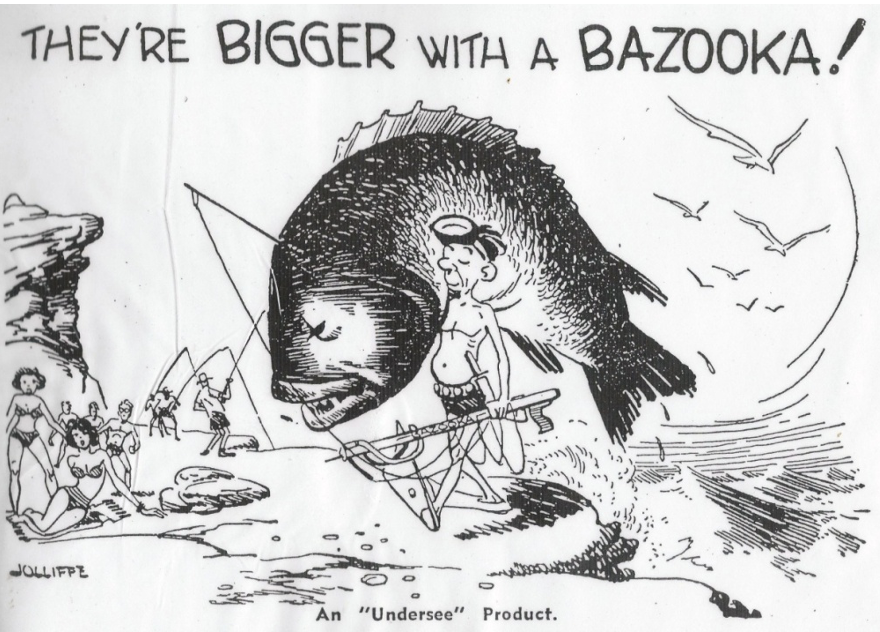
Undersee has seen several changes of ownership but is still producing spearguns to this day.
The late 1940’s and early 1950’s saw an influx of speargun manufacturers.
In January of 1949 in Fremantle WA Peter St Barbe Connor produced his “Connor” speargun whilst Jack Sue made a monstrous compressed air speargun a while later. Jack had seen action during the 2nd world war as a secret agent with Z Special Unit, an Allied Forces intelligence and commando unit operating behind Japanese Lines in Borneo. In 1951 he opened WA Skindivers, a retail store with premises in the Perth suburb of Midlands.
In Tasmania during 1952 Len Staples made a speargun he called the “Sportsman”. Len had been instrumental in forming the USFA of Tasmania and was its first President.

Meet the 'SPORTSMAN' , a new light-weight speargun now being manufactured by Len Staples, 6 Cheverton Parade, Sandy Boy, Hobart, Tasmania. The 'Sportsman' shoots a 30" shaft with a detachable head, easy to load.
In Victoria the firm of A Ringrose & Co. commenced manufacturing their Sea Sport range of spring guns. This was the only company in Australia that made a spring gun.
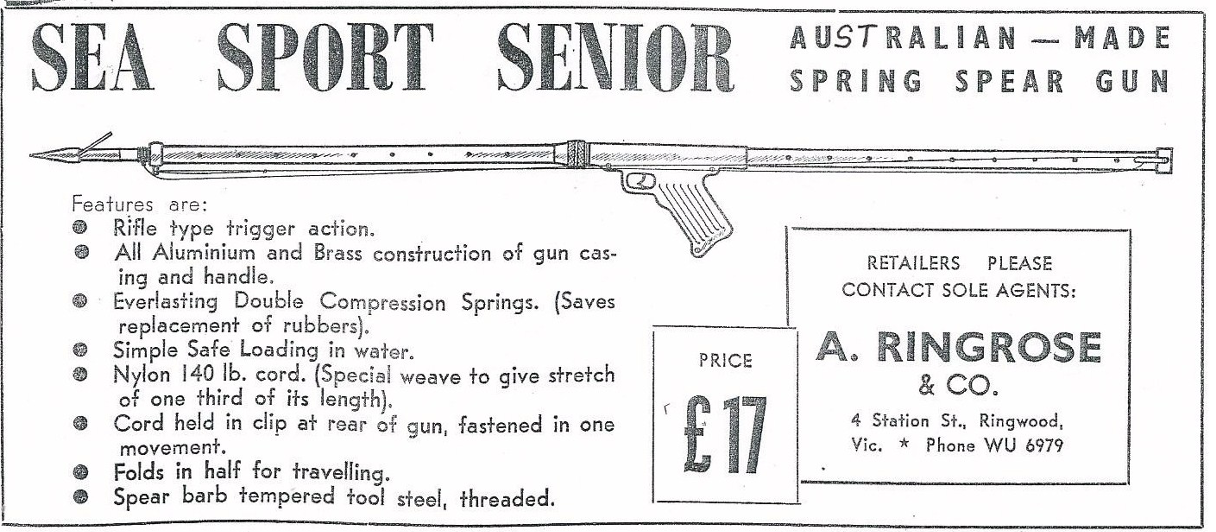
In Queensland Lyle Davis had begun making the spearguns that bear his name in 1952. This speargun had a patented front end to allow for rubbers to be changed easily. The speargun was made under license by Undersee Products from 1954 with the front end also licensed to be used by Undersee.
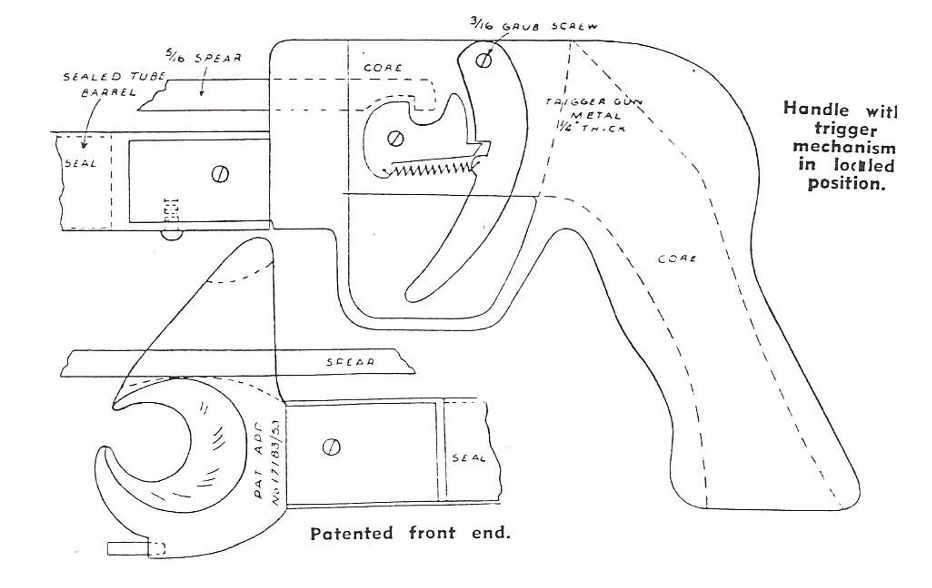
DRAWING SHOWING THE PATENTED LYLE DAVIS FRONT END

Lyle Davis and a gropcr he speared at Cudgeon Reef
In NSW the iconic Shoulder Gun or Carbine as it was also known had been introduced around 1947. The first known to have used this design was Jack Egan. As with others Jack had learnt to spearfish while stationed at Darwin during the 2nd World War. When asked how he came up with the idea Jack said that with his army training in the use of rifles it seemed the logical thing to do.
Australia’s greatest exponent in the use of the shoulder gun was without doubt Wally Gibbins. Jack Egan was using one when he first met a young Wally Gibbins while spearfishing in Sydney Harbour during 1947, and said he was certainly using his shoulder gun at this time. Wally soon adapted this gun to his own designs, with his first being made during 1947 or early 1948. His spearguns were manufactured using Ken Bateman’s workshop at Ken’s business, Coin Selectors. Ken said that in his workshop he could make absolutely anything.
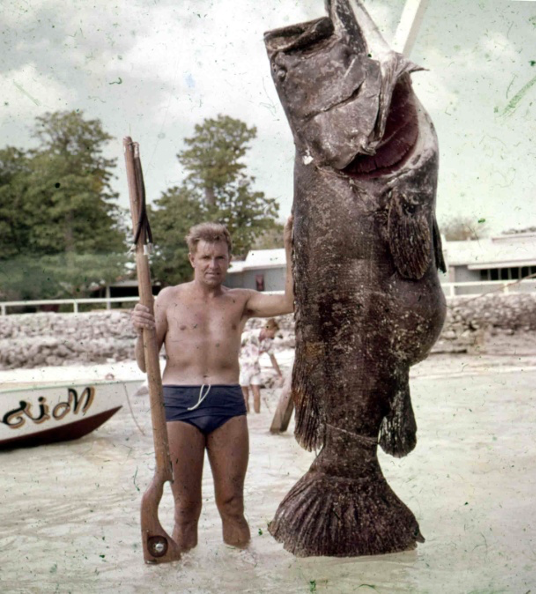
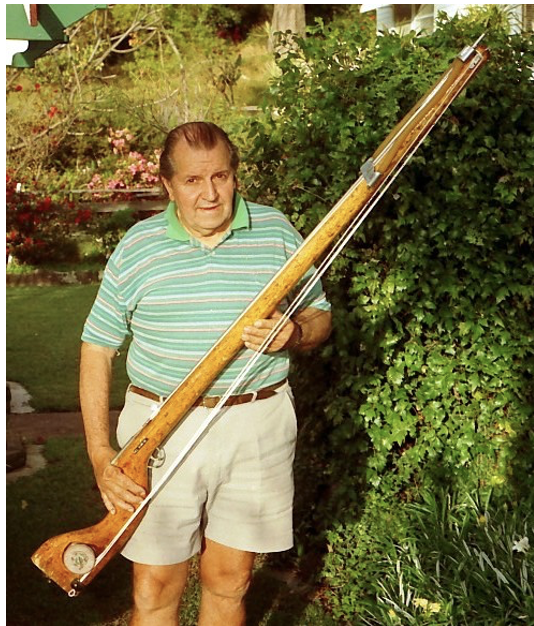
WALLY GIBBINS WITH HIS SHOULDER GUN
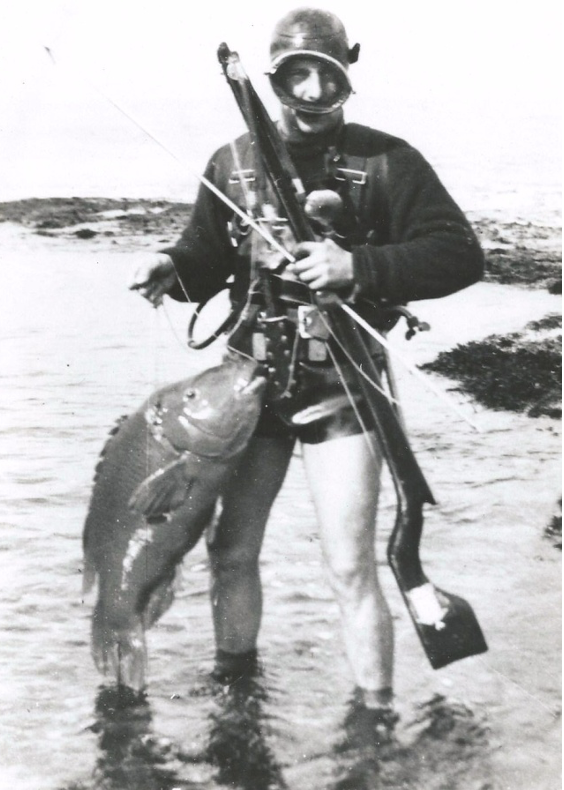
In 1950 Neville Cooke introduced his Marlin kit speargun. It was designed to enable access to cheap spearguns by doing the assembly work yourself.

1950 AVERTISEMENT FOR THE MARLIN KIT SPEARGUN
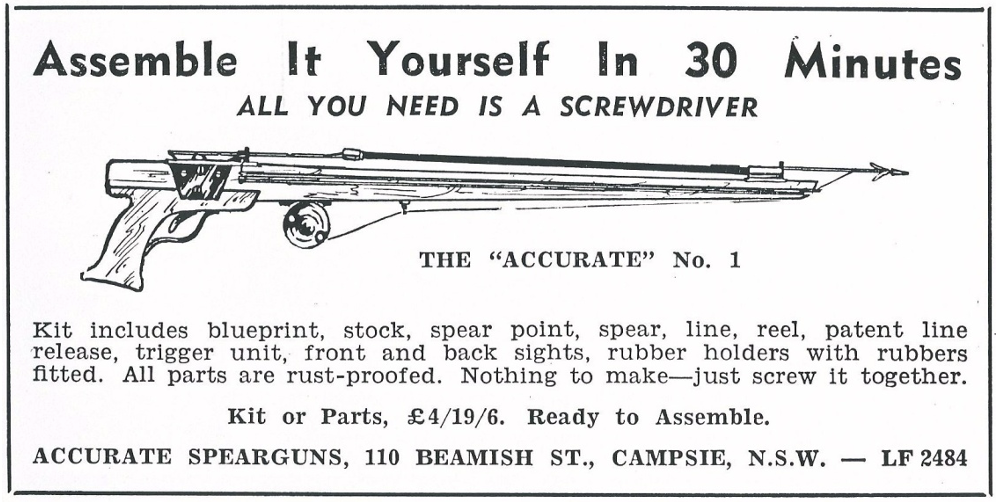
In 1951 Sydney spearfisher Andy Armstrong introduced his Mare Dama speargun with a completely redesigned shape introduced in 1952.

1951 MAGAZINE ADVERTISEMENT
In 1955 Turnbull Rubber Products entered the speargun market with their Rocket, Jet and Super Jet spearguns. Turnbull was the first Australian manufacturer of swim fins, also making masks and snorkels.
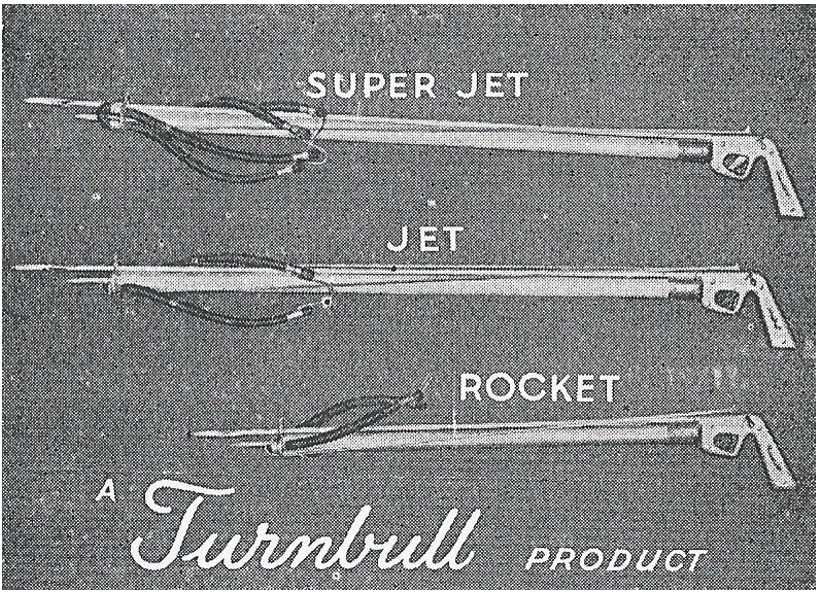
By 1956 there was a growing interest in CO2 powered spearguns and it was at this time that Michael Calluaud introduced his Sea Rocket speargun. Michael, of French nationality, came to Australia soon after the war and had learnt to dive with Jacques Cousteau.
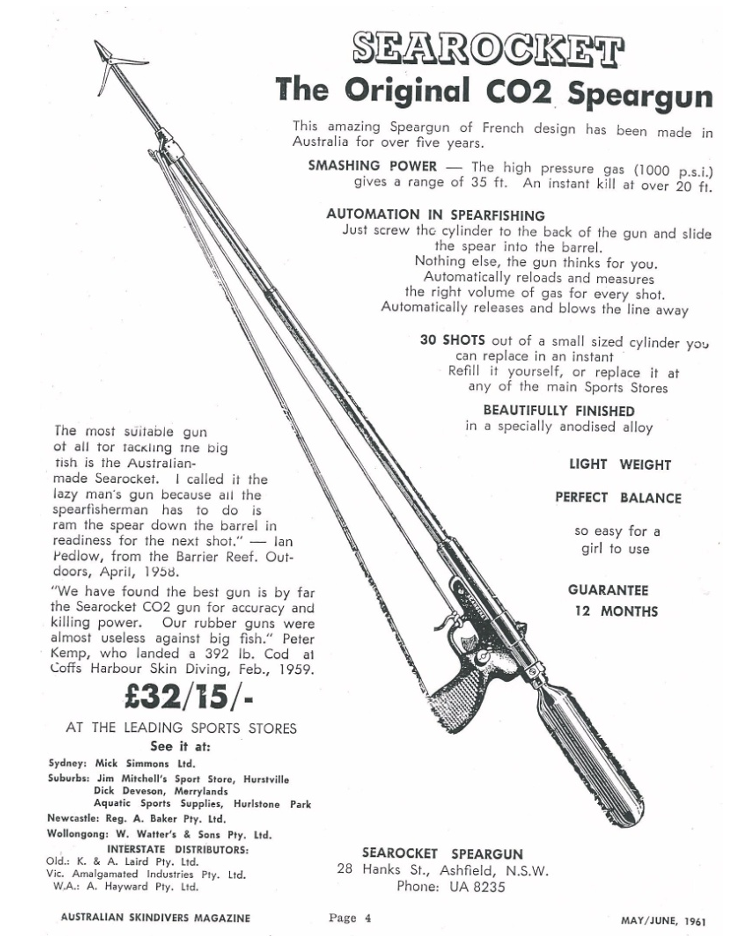
It was not until 1965 that we saw another entrant in the speargun market. T.D. Preece had established a small engineering business in 1952 and in 1960 launched the Sea Hornet brand with the making of handspears. His first spearguns came with both wooden and stainless steel barrels and were available in three sizes. Over the years Sea hornet has produced many design variations and has only recently ceased production.
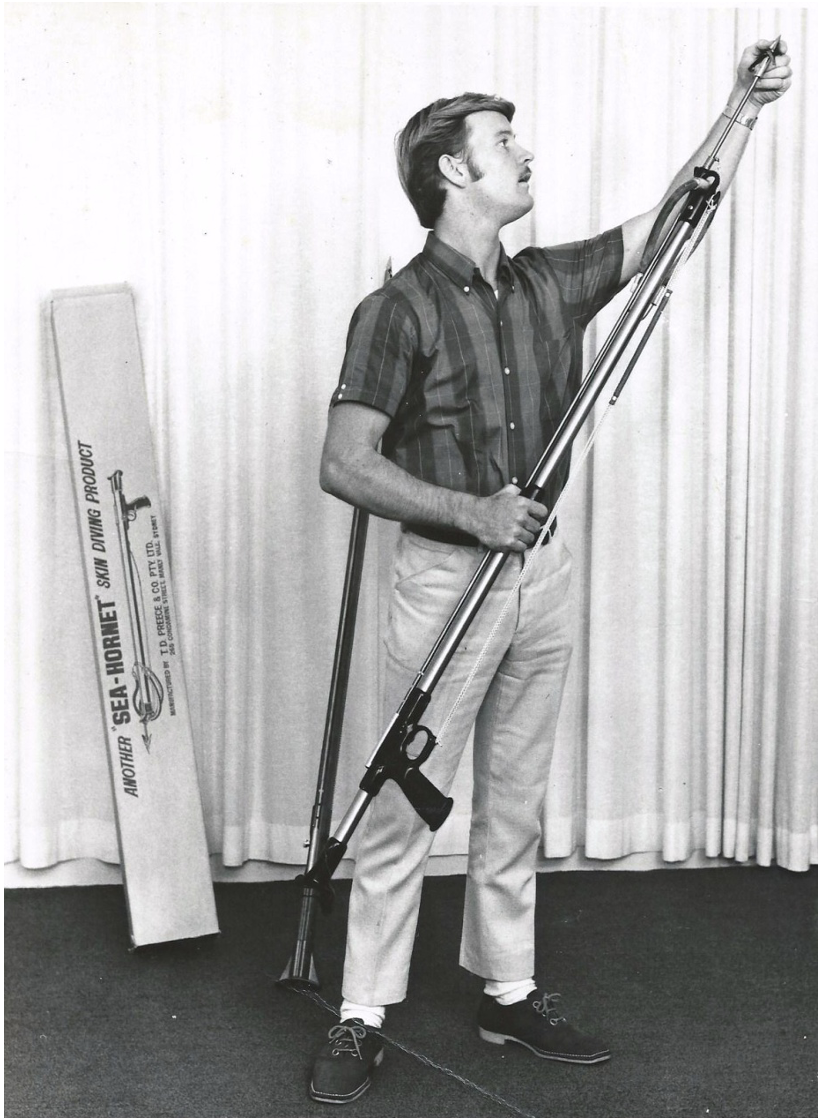
STEVE DUFFY SHOWS A SEA HORNET SPEARGUN
Following the 2nd World War the number of spearfishermen increased rapidly, and so too did the antagonism between anglers and speargunners (as they were then known). Protest letters were being sent to the Chief Secretary’s Department and letters to daily papers calling for the banning of the sport. Finally during 1947 an incident occurred which formed the catalyst for spearfishers to band together and form the USFA. Dick Charles and Bill Heffernan were spearfishing in the channel at the entrance to Tuggerah Lakes and had speared a few fish when they heard a Sergeant of Police calling out to them to get out of the water. They were told they were to be arrested and to get dressed and accompany him to the Police Station. They argued there was no law to say they could not go in the water and spear fish. After much argument on both sides the old sergeant was not too sure of whether he was coming or going and in the end away he went without carrying through with his threat. At this time they only knew two or three other spearfishers, but both agreed the only thing to do was to form an association to protect the rights of spearfishers. The problem was how to get in touch with others who were interested. Dick had a thought that the newspapers would print anything and ‘phoned the chief-of-staff of the Sydney Morning Herald telling him that a meeting had been called for all those who were interested in spearfishing, to be held at 3 pm at Long Reef on April 4, 1948 and afterwards there would be a mass dive by over 100 spearfishermen. The Sydney Morning Herald ran this as a front page article.When the appointed day arrived it was cold and raining. An early arrival saw the setting up of a table and a large Calico sign. Lunchtime came and it was still raining and cold and no one had arrived and they were getting a little worried. About an hour later cars started to arrive, then more and more and they were flat out answering questions and taking names and addresses.By 3 o’clock there were hundreds of people there and Dick Charles arose to address the crowd. He explained why they would have to form an association and band together if they wanted to continue spearfishing. It was a case of “united we survive, divided we fall”.Amongst others to speak at the meeting were Bill Heffernan, Frank Cunliffe and Les Hawley. It was decided that the association be formed. Dick Charles was elected as president, Frank Cunliffe and Bill Heffernan as Vice Presidents and Less Hawley Secretary/Treasurer and a committee of 15 appointed. Thirty two signed up as members and the association was on its way. The meeting then closed and about 50 men went into the shark infested waters, giving the press a field day with a few fish and a large ray being speared. Bill Heffernan stole the show by dressing in a World War two vintage shallow water diving suit.
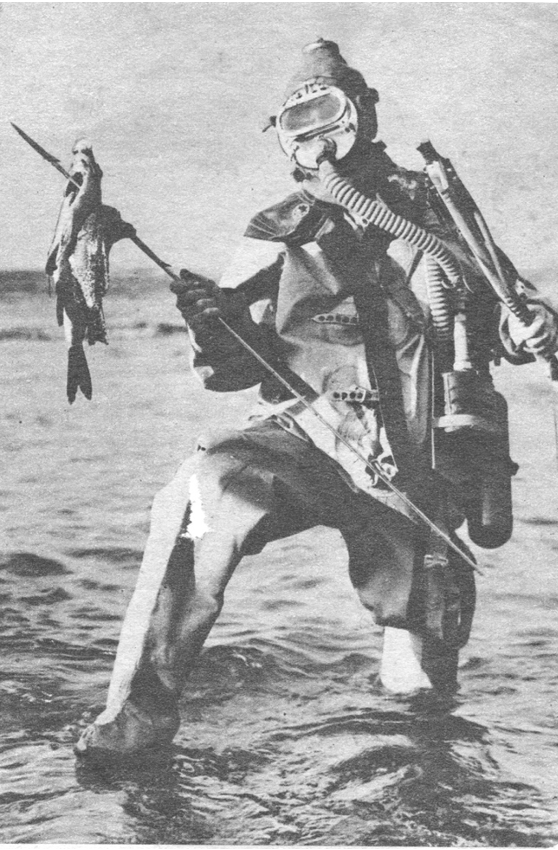
Equipment of spearfishermen varies. Here is a complicated outfit which enables
the wearer to stay under 435 min.
Following its formation the USFA drew up the following rules which were binding on all members.
However the complaints kept coming and the calls to ban spearfishing became more strident particularly from the United Fishermen’s League (the then representative body for commercial fishermen) with the claims being so outlandish it leads to the NSW Superintendent of Fisheries T C Roughley Leaping to our defence. The fishing scientist David G. Stead also spoke in our favor.
In his book Fish and Fisheries of Australia published in 1951 Theodore Roughley strongly defended spearfishing saying this about the USFA’s rules “Few sports are subject to such rigid discipline and tribute must be paid to members of the association for their careful adherence to the rules” and “Spear-gun fishermen have never been criticised, however, for taking undersized fish” and also “The sport of spearfishing (is) on a plane that few other sports were able to emulate”.
The USFA began to run spearfishing competitions at its monthly outings with its first annual event beginning in 1952 with a challenge to a competition between Anglers and Spearfishers issued by the Entrance District Angling Club.
The first Australian spearfishing Championships were held in 1953 and later that same year the first NSW Spearfishing Championships. With the following rules:
1. Only four fish of each specie allowed.
2. Fish to be 25% above legal size.
3. No Sharks or Rays allowed.
4.No underwater breathing devices allowed.
Right from the outset spearfishers demonstrated very conservation minded ethics, then in 1957 the rules were amended to allow one fish of each specie to be weighed in and all fish to be a minimum of 1lb. in weight. We were then leading the world with our conservative approach to fishing competitions.
During 1952 the USFA called for bag limits to be placed on all species of fish and concerns were expressed at the Blue Groper population. Subsequently a bag limit of 2 per person per day was imposed some six years later.
The formation of the NSW Amateur Fishermen’s Advisory Committee in 1968 saw George Davies appointed as the spearfishing representative, this then allowed our representative to request a complete prohibition on the taking of Blue Groper. A 5 year ban was subsequently imposed and then in 1974 it was relaxed to allow anglers to take 2 per day but imposed a complete ban on spearfishing.
Also in 1969, at the behest of the USFA spearfishing with Scuba was prohibited. This led to Scuba clubs breaking away from the USFA, forming their own organisation to oppose the ban.
SUMMARY
Indigenous Australians were spearing fish, probably for thousands of years, prior to European settlement.
1917 saw spearfishing as we know it, begin in Sydney Harbour.
Torres Straight and South Pacific Islanders had the greatest influence on how we spearfish.
Spearfishing grew rapidly in popularity after the World War 2.
Increasing calls to ban spearfishing led to the formation of the USFA in April of 1948.
1950’s - spearfishers adopt the world’s most conservative fishing practices.
1969: Protection of Blue Groper – Scuba spearfishing prohibition
1984: Protection of Grey Nurse Sharks followed by the protection of Queensland Groper, Estuary Cod, Blue Devil, Elegant Wrasse and Blue Fish. Bag and size limit protection for Red and Banded Morwong
____________